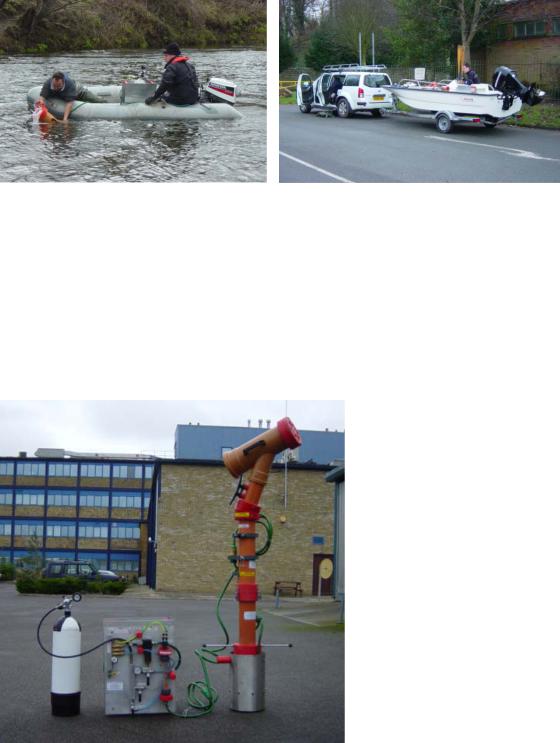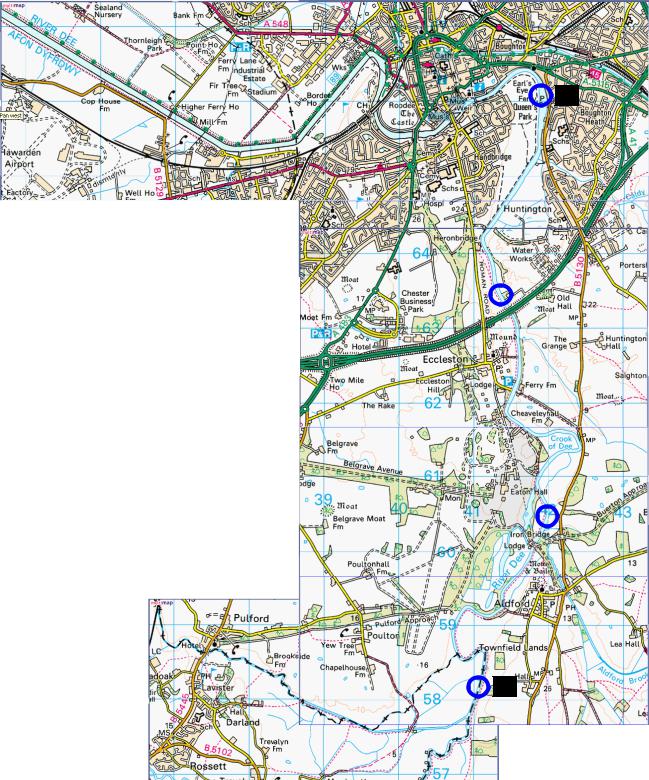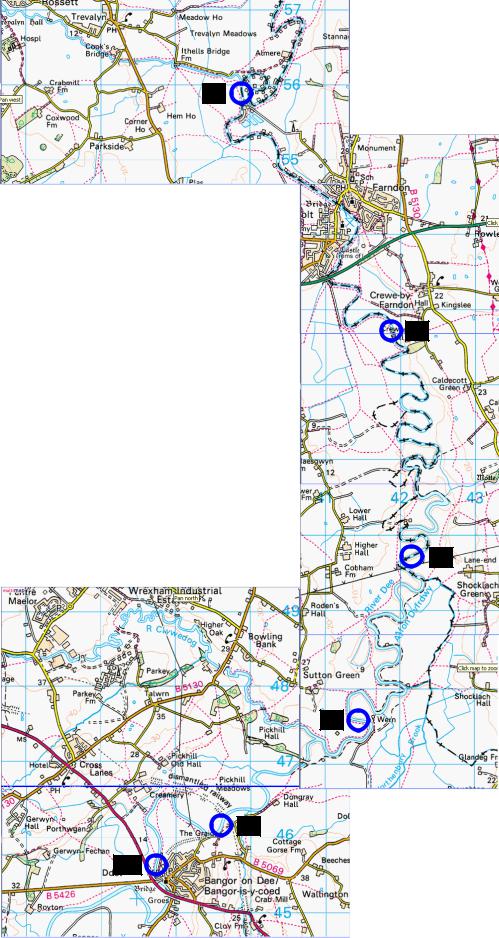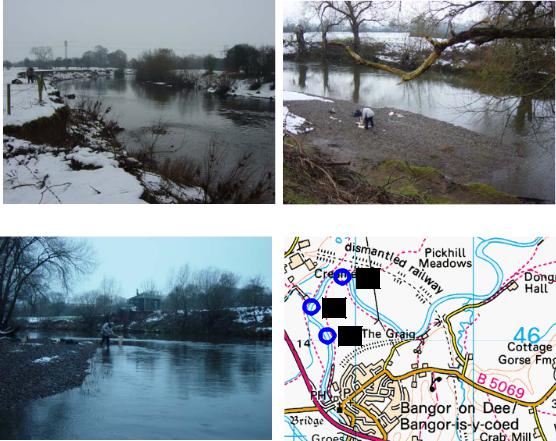
SUMMARY
Isogenus nubecula is a large species of stonefly that was typically found in large lowland rivers across much of Europe but has now been lost from much of its former range. Within the UK the distribution of I. nubecula is restricted to the River Dee in North Wales although it has not been recorded there since 1995 and its continued presence in the UK is therefore in doubt. While previous surveys have focused on kick sampling in the wadeable stretches of the middle reaches of the River Dee, this report describes an airlift survey of ten sites in the deeper lower reaches of the Dee undertaken in February 2007. Unfortunately, this survey, like all those in the past 12 years, also failed to find any more specimens. It is therefore recommended that the current Red Data Book category for I. nubecula of 2 (Vulnerable) should be raised to 1 (Endangered) and that I. nubecula should be scheduled as a UK Biodiversity Action Plan species. It is also recommended that Perlodidae stonefly nymphs from Environment Agency routine macroinvertebrate samples, from within the former range of I. nubecula in the River Dee, should be identified to species level. In the discussion we review the main pollution incidents that have occurred on the lower reaches of the River Dee in the last fifteen years and we also discuss the significant knowledge gaps that exist in our understanding of the habitat preferences and mating habits of I. nubecula adults.
CRYNODEB
Math o bryf cerrig mawr yw Isogenus nubecula sydd i’w weld fel arfer mewn afonydd mawr ar dir isel ar draws llawer o Ewrop. Erbyn hyn, fodd bynnag, mae wedi diflannu o nifer o’r mannau hyn. O fewn y DU, caiff dosbarthiad I. nubecula ei gyfyngu i Afon Dyfrdwy yng Ngogledd Cymru, er nad yw wedi ei gofnodi yno ers 1995. O’r herwydd, ni cheir sicrwydd ei fod i’w gael o hyd yn y DU. Mae arolygon y gorffennol wedi canolbwyntio ar gynnal samplau cicio yn rhannau canol Afon Dyfrdwy, yn y mannau y gellir eu rhydio. Fodd bynnag, mae’r adroddiad hwn yn disgrifio arolygon a gynhaliwyd fis Chwefror 2007 ar ddeg o safleoedd yn rhannau dyfnaf Afon Dyfrdwy, lle defnyddiwyd offer mewn cwch i samplo gwely’r afon. Yn anffodus, fel yr arolygon a gynhaliwyd yn ystod y deuddeng mlynedd diwethaf, methodd yr arolwg hwn â dod o hyd i fwy o samplau. Felly, argymhellir y dylai categori’r Llyfr Data Coch ar gyfer I. nubecula, sef 2 (Dan Fygythiad), gael ei godi i 1 (Mewn Perygl), ac y dylid rhestru I. nubecula fel un o rywogaethau Cynllun Gweithredu’r DU dros Fioamrywiaeth. Argymhellir hefyd y dylid nodi beth yw rhywogaethau nymffau’r pryf cerrig perlodid a geir yn samplau macroinfertebrat Asiantaeth yr Amgylchedd o fewn dosbarthiad blaenorol I. nubecula yn Afon Dyfrdwy. Yn y drafodaeth, rydym yn adolygu’r prif ddigwyddiadau llygredd sydd wedi dod i ran rhannau isaf Afon Dyfrdwy yn ystod y pymtheg mlynedd diwethaf, ac rydym hefyd yn trafod y bylchau sylweddol a geir yn ein dealltwriaeth ynghylch pa gynefinoedd sydd orau gan I. nubecula llawndwf a beth yw eu harferion paru.
1
1.INTRODUCTION
Isogenus nubecula Newman (Plecoptera: Perlodidae) is a rare stonefly with a distribution in the United Kingdom that is currently uncertain. I. nubecula was first recorded in the United Kingdom in 1959 (Hynes, 1963) from the River Dee in North Wales at Bangor-is-y-coed (also known as Bangor-on-Dee). The first extensive survey to determine the range of I. nubecula was conducted in 1982 (Mills & Andrew, 1984) where it was found at nine sites over a 45km stretch of the River Dee between Newbridge (SJ288416) and just downstream of the River Alyn (SJ399561). In a similar survey of the River Dee in 1993 (Bowker, 1995), I. nubecula was recorded at 5 sites between Overton Bridge (SJ355428) and Wern (SJ413479). Since 1993, only one specimen of I. nubecula has been recorded in the United Kingdom. This individual was found in a routine General Quality Assessment sample taken from the R. Dee at Erbistock (SJ356413) in 1995. Despite further surveys in 1997 (Tanner, 1997), 1998 (Millband, 1998), 2003 (Davy-Bowker, 2003) and 2003/4 (Hammett & Wallace, 2005) no further specimens of I. nubecula have been found. A fuller review of the European status of I. nubecula is given in Davy-Bowker (2003).
While previous surveys of I. nubecula have focussed on kick sampling in wadeable habitat within the historical range, and searches for adults and exuviae, this survey attempts to address the question of whether I. nubecula might be present in the deeper lower reaches of the River Dee that have to date received little or no specific survey attention other than the routine monitoring carried out by the Environment Agency and its predecessors. The lower Dee between the downstream limit of the historical range of I. nubecula (i.e. between the confluence with the River Alyn and Chester weir) is characterised by deep water and a highly sinuous meandering channel and a substratum composed of fine gravel and sand with occasional areas of silt and mud. The lower Dee is therefore extremely difficult to sample by kick sampling, as it is generally too deep to wade except at isolated locations either where the river widens or a shallow area exists on the inside of a tight bend. This survey therefore attempted to obtain mid-channel samples from the deep water reaches of the lower River Dee using an airlift sampling device in the hope that this habitat may still contain a population of I. nubecula.
2.METHODS
The airlift samples were taken using two boats; an inflatable boat with a small 9.9 horsepower (hp) engine was used to sample sites in the shallower water near Bangor- on-Dee, while a larger boat with a more powerful (60hp) engine was used to sample the deeper water sites (Fig 1). The smaller boat was chosen as it was thought to be better suited to reaching shallower water, however, we found that the small boat was not able to do this as its engine could not be raised to a shallow draft position. The 9.9hp engine was also seriously under-powered for a River of this size and current velocity and we advise against its use in this role in future on health and safety grounds as it could only make walking pace progress against the flow when travelling upstream. The larger rigid hulled boat performed better in every way. The variable pitch engine and flat bottom meant that it was well suited to shallow water and the powerful 60hp engine meant that it could easily transport 2 people and the airlift sampling equipment for long distances against the fast flow of the river.
2

Figure 1. Airlift sampling using a small inflatable boat with 9.9hp engine at Bangor- on-Dee on 9th January 2007 (left) and (right) the larger rigid hulled boat with 60hp engine used for sampling the lower reaches of the River Dee on 10th January 2007.
The airlift sampling was carried out on the 9th and 10th January 2007, as this was though to be early enough in the year for any I. nubecula not to have emerged as adults. The sampling could not be done for several weeks prior to this because of substantial flooding of the River Dee due to heavy rainfall. The return visit to the River Dee to take kick samples took place on the 10th February 2007.
The airlift sampler (Fig 2.) was operated by releasing compressed air down a hose that emerged at the end of a 2 metre long pipe (internal diameter ~110mm) to produce a vertically rising column of water inside the pipe that then washed through a 1mm net bag where the sample was gathered. After lowering the airlift over the side of the boat and turning on the compressed air at a rate sufficient to generate a column of rising water, sampling was done by gently bouncing the device over the river bottom.
Figure 2. The airlift sampler (manufactured for CEH by Duncan Associates, Jeeves Bank, Fernleigh Road, Grange-over-sands, Cumbria, UK)
Although the airlift was heavy and at times difficult to handle, it became lighter when the compressed air was running and the whole device was submerged. At each site we achieved about 5 minutes of active sampling and consumed about 1 compressed air cylinder per site (we had 12 full cylinders for the entire survey and used about 10 of these). The high water currents at some sampling sites also presented difficulties, making it difficult to keep the airlift vertical as it bounces on the riverbed. We used a method to counter act this problem by first boating upstream and then sampling whilst
3

35 |
36 |
37 |
38 |
39 |
40 |
41 |
42 |
43 |
1
Figure 3. River Dee sites sampled |
|
|
by airlift on the 9th* and 10th∆ |
|
|
2 |
||
January 2007 |
||
|
1) |
Dee at Earl’s Eye∆ |
|
|
|
SJ 419 659 |
|
|
2) |
Dee u/s Heron Bridge∆ |
|
|
|
SJ 413 634 |
|
|
3) |
Dee d/s Iron Bridge∆ |
|
|
|
SJ 419 604 |
|
|
4) |
Dee u/s Townfield Lands∆ |
|
|
3 |
|||
|
SJ 410 581 |
||
|
|
67
66
65
64
63
62
61
60
59
4
58
42 43
37 |
38 |
39 |
40 |
41 |
4

37 |
38 |
39 |
40 |
41 |
5
55
5) |
Dee u/s R. Alyn∆ |
54 |
|
SJ 399 558 |
|
6) |
Dee at Crewe Hill∆ |
|
|
SJ 418 527 |
53 |
|
|
6 |
7)Dee at Shocklach Green∆ SJ 421 497
52
8) Dee at Wern*
SJ 414 475
9)Dee at The Graig* SJ 395 461
10)Dee at Bangor-on-Dee* SJ 387 456
49
48
51
50
7
49
48
8
47 |
47 |
42 43
42 43
9
46
10
45
37 |
38 |
39 |
40 |
41 |
5

drifting with the flow of the river. Some of the lower Dee sites were deeper than the length of the airlift device and at these sites we submerged the airlift on a rope. From this we estimate that some of the lower River Dee sampling sites were approximately 5 metres deep.
On the first day of airlift sampling (9th January 2007) we launched the inflatable boat in the lee of the old bridge at Bangor-on-Dee and took airlift samples from the River Dee at Bangor-on-Dee, The Graig and Wern, and then boated back upstream to Bangor-on-Dee to disembark. We also searched the bridge at Bangor-on-Dee for exuviae. On the second day (10th January 2007) we launched the larger boat from the Sandy Lane slipway in Chester (NGR SJ 419 659) and over the course of about 2 hours boated up river to Shocklach Green to take our first airlift sample. We then boated back down river taking airlift samples at the remaining sampling sites (Fig 3). A letter of permission to take our boat on the river was obtained from Chester County Council as our survey was early in the year and day boating licences were not yet available to buy from the Council.
On the first day of sampling around Bangor-on-Dee, during the course of travelling by boat, several areas of shallow wadeable water, which the authors had not sampled in previous surveys, were observed. These lay within the historical range of I. nubecula and we wanted to kick sample these sites (these being too shallow to airlift) but there was insufficient time on the day. This prompted a return visit to the River Dee one month after the airlift survey to take additional kick samples (Fig 4.)
Site A, NGR SJ 388 460 |
Site B, NGR 386 463 |
Site C, NGR SJ 389 466 |
39 |
40 |
C
B
A
Figure 4. Shallow wadeable sites A, B and C, kick sampled on a return visit to the River Dee on 10th February 2007.
6

All of the airlift samples collected were preserved in a final concentration of ~4% formaldehyde and subsequently picked for Perlodidae at the CEH Dorset laboratory. The kick samples collected on the 10th February were picked for Perlodidae in the field.
3.RESULTS AND DISCUSSION
Sadly none of the samples collected (airlift or kick samples) yielded any specimens of I. nubecula and no exuviae were found either on Bangor-on-Dee bridge or on any trees at any other locations visited. Sites 9, 10, A, B and C all contained good populations of Perlodes microcephala although these also became much less frequent at the deep water sites further down the River Dee. We can only speculate about the real reason for the decline of I. nubecula, some of the pressures that may have contributed are described below.
Firstly, long term Environment Agency data indicates that the River Dee generally has good Biochemical Oxygen Demand (mg/l), Ammonia (mgN/l) and dissolved Oxygen (percentage saturation) in the centre of the former range of I. nubecula (Table 1).
R. Dee, Overton Drain (SJ365421) to confluence with R. Clywedog (SJ409473)
2003 to 2005 |
A |
2002 to 2004 |
A |
2001 to 2003 |
A |
2000 to 2002 |
A |
1999 to 2001 |
A |
1998 to 2000 |
A |
1997 to 1999 |
B |
1996 to 1998 |
B |
1995 to 1997 |
B |
1994 to 1996 |
A |
1993 to 1995 |
A |
R. Dee, R.Clywedog (SJ409473) to confluence with Worthenbury Brook (SJ423494)
2003 to 2005 |
A |
2002 to 2004 |
A |
2001 to 2003 |
B |
2000 to 2002 |
B |
1999 to 2001 |
B |
1998 to 2000 |
B |
1997 to 1999 |
B |
1996 to 1998 |
B |
1995 to 1997 |
A |
1994 to 1996 |
A |
1993 to 1995 |
A |
1992 to 1994 |
A |
1991 to 1993 |
A |
1988 to 1990 |
B |
Table 1. Water quality class (based on BOD, Ammonia and dissolved Oxygen) in two stretches of the R. Dee that cover the majority of the 1993 distribution of I. nubecula.
7

However, Environment Agency biological data from the River Dee shows that the while the quality of river was generally class A or B between 1990 and 2004, there was a distinct drop in quality of the Dee downstream of the River Clywedog in 1995 when the River Dee was class D (Table 2).
R. Dee, Overton Drain (SJ365421) to confluence with R. Clywedog (SJ409473)
2004 |
A |
2000 |
B |
R. Dee, R.Clywedog (SJ409473) to confluence with Worthenbury Brook (SJ423494)
2003 |
B |
2000 |
A |
1995 |
D |
1990 |
B |
Table 2. Biological quality (based on observed/expected NTaxa and ASPT) in two stretches of the R. Dee that cover the majority of the 1993 distribution of I. nubecula.
While the poor biological quality of the River Dee downstream of the River Clywedog in 1995 was not apparent in routine water quality monitoring, there have been several significant pollution incidents on the river Dee and the River Clywedog in recent years that could caused this deterioration in quality. The most significant pollution incidents in the last 15 years are presented in Table 3.
Year |
Pollution incident/chronic effect |
Uncertain |
Cyanide incident at 5 Fords STW. Date uncertain but within period of |
|
interest. Cyanide caused failure of 5 Fords STW, substantial fish kill |
|
on River Clywedog but R. Dee drinking water was unaffected. |
Early 1990s |
Formaldehyde incident from Kronospan, Newbridge. Approx 5000 |
|
litres formaldehyde resin released from damaged road tanker. Peaked |
|
at 100 ppm in R. Dee. Was biodegraded quite rapidly although DO |
|
sag did occur. |
1990s |
5 Fords STW outfall redirected from Clywedog to outfall directly |
|
into R. Dee (outfall is now located just upstream of the confluence of |
|
the Clywedog with the Dee). Clywedog must have been providing |
|
some final treatment so the local conditions around the new outfall |
|
may have worsened. |
Long-term |
Chronic Chloride inputs from Monsanto, Newbridge. U/s Monsanto |
& chronic |
Chloride ~ 10-20 (units uncertain) while d/s ~ 50-60. By 5 Fords rises |
|
again to 60-70. May combine with saline intrusions to make Chloride |
|
near streambed high. |
1994 |
Toluene incident at Trefnant Brook, Newbridge. From Monsanto. |
|
Levels were low. |
2000 |
Approx 100,000 fish killed as pollution from 5-Fords STW. Huge |
|
dissolved Oxygen sag (down to ~1%), lasting approx 6-8 hours. Very |
|
low dissolved Oxygen (1-5%) down as far as Chester for 12 hours or |
|
more. |
Table 3. Chronic and acute pollution pressures on the River Dee in recent years (information provided by Dave Andrew, Environment Agency, Buckley Office and Helen Millband, EA, Bangor Office).
8
The pollution incidents generally divide into two classes – those from 5 Fords Sewage Treatment Works/Wrexham Industrial Estate, affecting the River Clywedog and the River Dee below the population centre of I. nubecula at Bangor-on-Dee/Pickhill Meadows, and those from Kronospan/Monsanto at Newbridge affecting the whole former range of I. nubecula. It is impossible to be certain whether any of these pollution incidents have caused the decline in I. nubecula although those arising from Newbridge are the greatest concern as they affect the whole historical range of the species and could therefore have could caused the entire population to go extinct.
Overall, the River Dee generally has good enough water quality to support I. nubecula although the periodic pollution incidents are clearly a source of concern, especially those that enter the Dee upstream of Bangor-on-Dee.
Another potential cause for concern is river temperature. Generally speaking, members of the Perlodidae tend to prefer cold water so an obvious worry is that global warming may make the River Dee less suitable. However, Hoffsten (2003) in a study in Sweden concluded that I. nubecula was rare in Sweden because it is really a central European species and that Swedish rivers were too cold. A further complication is the regulation of the River Dee that results in additional cold water being added during the summer months. The influence of river temperature on I. nubecula in the River Dee therefore needs more study before any conclusions can be drawn.
The last pressure on I. nubecula that should be mentioned is the loss of terrestrial habitat. During 2003, major flood defence banks were constructed at the main site where I. nubecula has been found in the past (Bangor-on-Dee). The flood defence banks, photographed in Davy-Bowker (2003), have resulted in the loss of some of the riparian habitat that might be important for I. nubecula adults. In fact, we know very little about the requirements of adult I. nubecula and this is an area where we clearly need more information. For example, based on Perlodes microcephala, we can assume that I. nubecula males probably climb trees and drum their abdomens against the tree bark to attract females. The females probably fly up to the males and mate. However, we don’t know if the presence of trees has a positive impact on I. nubecula breeding success or what kind of cover the adults use. Neither are we sure whether the adults are active during the day or night (although the night seems more likely). There are clearly many questions that need to be answered before we can hope to suggest a riparian management strategy that might promote the survival of the species.
4.RECOMMENDATIONS
The following recommendations are made:
4.1Environment Agency routine macroinvertebrate family level samples from within the former range of I. nubecula in the River Dee should be fully picked for Perlodidae. Perlodidae specimens should be either identified to species level or retained for future reference.
4.2Further survey work should be considered (possibly in autumn rather than spring) to see if I. nubecula can still be found in the Dee (and hence the UK).
4.3I. nubecula should be raised from UK Red Data Book status 2 (Vulnerable) to RDB1 (Endangered).
4.4I. nubecula should be scheduled as a UK Biodiversity Action Plan species.
9
5.ACKNOWLEDGEMENTS
We would like to thank the following people for their help in carrying out this project: Mike Howe (Countryside Council for Wales) for his help in obtaining CCW funding support, Dave Andrew, Arthur Arrowsmith, Max Gooch and Helen Millband (Environment Agency) for information on pollution incidents and River Dee water levels, Chester County Council for arranging out of season boating permission for the River Dee and use of the Sandy Lane slipway in Chester and Ieuan Jones of The Royal Oak, Bangor-on-Dee for allowing us to park our many vehicles and boats in his car park. This work was jointly funded by the Centre for Ecology & Hydrology and the Countryside Council for Wales.
6.REFERENCES
Bowker J. (1995) Records of Isogenus nubecula Newman (Plecopt., Perlodidae) from the Welsh River Dee. Entomologist’s Monthly Magazine. 131: 69-70.
Davy-Bowker J. (2003) A survey of the Welsh River Dee for the rare stonefly Isogenus nubecula Newman in February 2003. A report by the Centre for Ecology & Hydrology, (Dorset).
Hammett M.J. & Wallace I.D. (2005) A survey for the stonefly Isogenus nubecula (Newman) on the Welsh River Dee and its tributaries (December 2003 to April 2004). Countryside Council for Wales (Bangor), Contract Science Report No. 717.
Hoffsten P.-O. (2003) Rarity in boreal stream: patterns, causes and consequences. http://urn.kb.se/resolve?urn=urn:nbn:se:umu:diva-142T (2007-04-02)
Hynes H.B.N. (1963). Isogenus nubecula Newman in Britain (Plecoptera: Perlodidae).
Proceedings of the Royal Entomological Society London (A). 38: 12-14.
Millband H. (1998). The status of the rare stonefly, Isogenus nubecula, in the middle Dee. A report by the Environment Agency, Welsh Region.
Mills M.J. & Andrew D. (1984). Isogenus nubecula Newman (Plecoptera: Perlodidae) in the Welsh River Dee. Entomologist’s Gazette, 35: 45-51.
Tanner J.M. (1997). A survey of the Welsh River Dee for the rare stonefly Isogenus nubecula. A report by the Environment Agency, Welsh Region.
10
